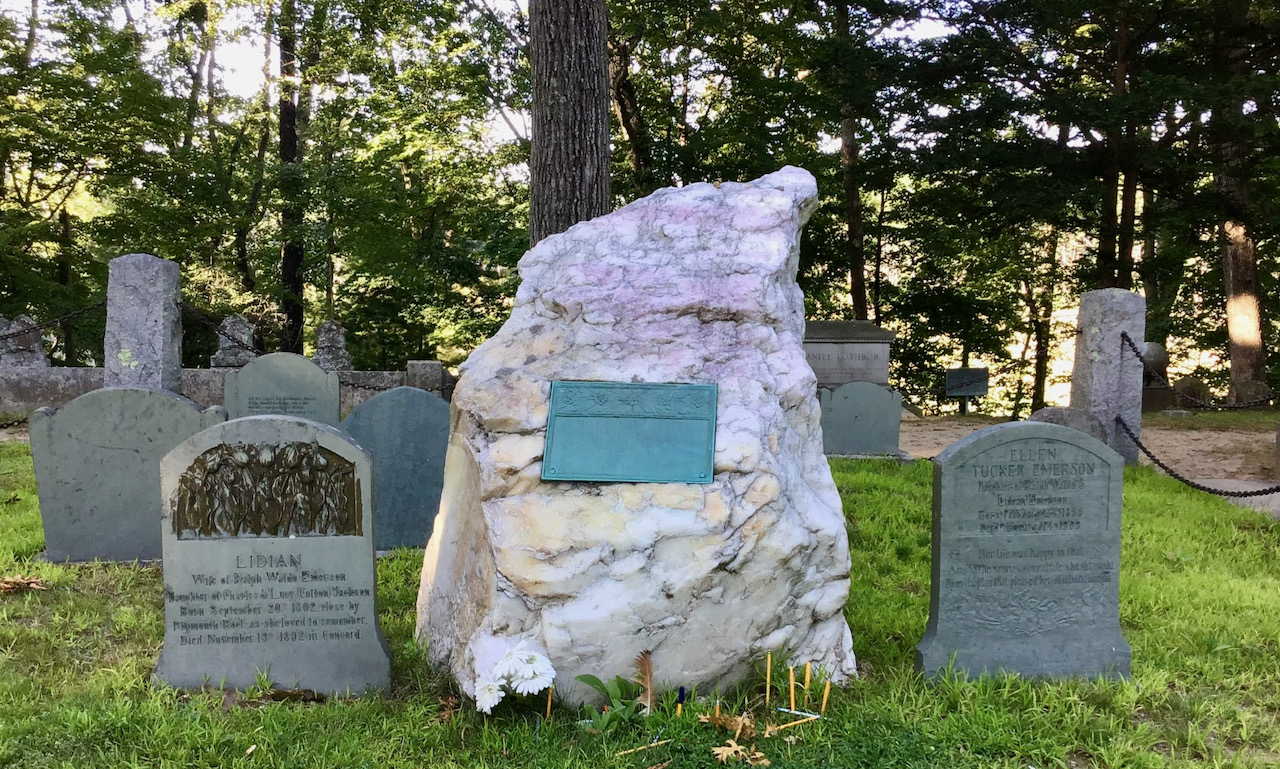One of Massachusetts’ most prominent “rural” or “garden” cemeteries, Sleepy Hollow is the work of two major landscape designers of the second half of the nineteenth century, H. W. S. Cleveland and Ernest Bowditch. Its design, echoes that of Cambridge’s Mount Auburn Cemetery, the first garden cemetery in the country.
At its consecration on September 29, 1855, Concord resident Ralph Waldo Emerson provided opening remarks. Emerson’s “Address to the Inhabitants of Concord at the Consecration of Sleepy Hollow,” informed his essay on immortality and is marked by his characteristic lilting prose and insightful observations about a subject and a place he knew intimately. If, as Professor Daniel Nadenicek suggests, Sleepy Hollow represents Emerson’s “philosophy made substance,” the cemetery is also a unique fusion of the poet/philosopher’s voice and the landscape artist’s eye.
Sleepy Hollow’s “Author’s Ridge” is the resting place of some of Concord’s most noted writers and their families, including Louisa May Alcott, Ralph Waldo Emerson, Henry David Thoreau and Nathaniel Hawthorne.
It is also the site of what is considered one of Daniel Chester French’s most celebrated sculptures, the Melvin Memorial, also known as Mourning Victory, honoring three brothers from Concord who died in the Civil War. French designed other monuments in Sleepy Hollow, including the bronze plaques for the graves of his sister, Sarah French Bartlett, and her husband, Edward J. Bartlett. He is buried behind the Melvin Memorial.
Following In Thoreau’s Footsteps
The oldest part of the cemetery was created in 1823 and was known as the New Hill Burying Ground. Located just to the left of the main gate is the Thoreau-Dunbar plot. It was here that Henry Thoreau was buried in 1862. Also in the plot were his brother John, Jr. (d. 1842), his sister Helen (d. 1849) and their father, John, Sr. (died. 1859). Also buried here are Thoreau’s maternal grandmother, Mary Jones Dunbar Minot, as well as his Uncle Charles Dunbar and his Aunt Louisa Dunbar.
Henry Thoreau’s mother, Cynthia Thoreau (nee Dunbar) died in 1872, leaving only her youngest daughter, Sophia, as the lone surviving member of the family. Cynthia was buried in the Thoreau-Dunbar plot but sometime after 1872 Sophia had the remains of her immediate family moved to the adjacent Sleepy Hollow Cemetery. Sophia died in 1876; she was buried next to her brother Henry in the Thoreau family plot on what is now Author’s Ridge.
Long before it became a cemetery, the wild, wooded area was known as “Sleepy Hollow”. The cemetery was designed by noted landscape architects H.W.S. Cleveland and Robert Morris Copeland, and Henry Thoreau was hired to do some of the surveying for the new burial ground. The designers had fitted the walks and drives into the site’s natural amphitheater and left much of the area’s original vegetation in place, instead of removing it and replanting with ornamental shrubs. An abundance of wild plants such as woodbine, raspberry, and goldenrod, as well as the natural moss and roots of pine trees were also left by the designers.
It was dedicated on September 29, 1855 and Ralph Waldo Emerson gave the dedication speech. Although it is a cemetery, Emerson said that it is also “ a garden of the living.” The Emerson family plot was chosen on the top of a ridge near the hollow. The Alcotts, Hawthornes, and Thoreaus would also be buried there and by the 20the Century it would become known as Author’s Ridge. Harriet Lothrop (AKA Margaret Sidney) would be buried on Author’s Ridge in 1924. Other notable figures laid to rest there include Sarah Alden Bradford Ripley (d. 1867), and Thoreau’s best friend, the Poet Ellery Channing.
Sleepy Hollow is Concord’s largest and only active cemetery. The back of the newer portion of the cemetery leads to a path system which connects to the Great Meadows National Wildlife Refuge. Visitors are asked to show proper respect when visiting.

